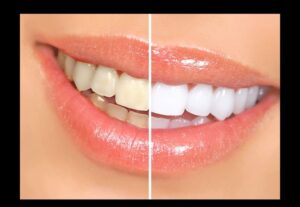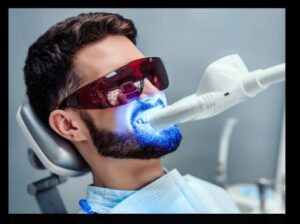A bright, white smile can significantly boost your confidence and improve your overall appearance. Over time, however, factors like food, drinks, tobacco use, and even aging can cause teeth to become discolored or stained. Fortunately, modern dentistry offers several options for teeth whitening, allowing you to restore the natural brilliance of your smile.
In this guide, we’ll take a look at what teeth whitening is, the different methods available, and how you can achieve a whiter smile that lasts.
Teeth whitening is the process of lightening the color of your teeth by removing stains and discoloration. The most common causes of teeth discoloration include:
• Foods and beverages: Coffee, tea, red wine, and dark-colored foods can stain your teeth over time.
• Tobacco use: Smoking or chewing tobacco can cause yellow or brown stains.
• Aging: As we age, the enamel on our teeth naturally wears down, revealing the yellower dentin underneath.
• Poor oral hygiene: Inconsistent brushing and flossing can lead to plaque buildup and surface stains.
• Medications: Certain medications, such as antibiotics like tetracycline, can cause discoloration in teeth.
• Genetics: Some people naturally have more yellowish teeth due to their genetics.
While you can’t always stop the natural aging process or avoid every stain-causing food, teeth whitening treatments can help reverse or reduce the appearance of discoloration, giving you a more radiant, youthful smile.
There are several ways to whiten your teeth, ranging from over-the-counter products to professional treatments. The right option for you will depend on your budget, time, and the level of staining you’re dealing with.
1. Professional In-Office Teeth Whitening
If you’re looking for fast, dramatic results, professional teeth whitening performed by your dentist is the best option. In-office treatments use stronger whitening agents than at-home products, and the process is monitored by a professional to ensure safety and effectiveness.
How it works:
• A whitening gel containing hydrogen peroxide or carbamide peroxide is applied to your teeth.
• A special light or laser may be used to activate the whitening gel and speed up the process.
• The treatment usually takes 60 to 90 minutes, with immediate results after just one session.
Pros:
• Fast results: A noticeably brighter smile in just one visit.
• Safe and effective: The procedure is supervised by a dental professional to ensure maximum results with minimal sensitivity or damage.
• Customized: The strength of the whitening treatment can be tailored to your needs.
Cons:
• Cost: In-office treatments are typically more expensive than at-home options.
• Sensitivity: Some patients may experience temporary tooth sensitivity after the procedure.
2. At-Home Teeth Whitening Kits (Professional Grade)
For those who prefer to whiten their teeth at home, many dentists offer take-home whitening kits. These kits typically involve custom-made trays that you fill with a whitening gel and wear for a specific period each day. They deliver results gradually over the course of several days or weeks.
How it works:
• Your dentist will take impressions of your teeth to create custom whitening trays that fit snugly over your teeth.
• You apply a professional-strength whitening gel to the trays and wear them for a designated amount of time each day.
• Depending on the product, results can take anywhere from a few days to a few weeks.
Pros:
• Custom-fitted trays ensure even whitening and comfort.
• Professional-grade formula is more effective than over-the-counter options.
• Convenient: You can whiten your teeth at home on your schedule.
Cons:
• Time-consuming: Takes longer to achieve results compared to in-office treatments.
• Cost: Though less expensive than in-office whitening, these kits still cost more than over-the-counter products.
3. Over-the-Counter Teeth Whitening Products
If you’re looking for a more affordable solution, there are several over-the-counter whitening products available. These products, such as whitening toothpaste, strips, gels, and trays, are easily accessible and relatively inexpensive.
How it works:
• Whitening toothpaste: Contains mild abrasives or chemicals that help remove surface stains.
• Whitening strips: Thin plastic strips coated with a whitening gel that you apply directly to your teeth. They’re typically worn for 30 minutes to an hour each day.
• Whitening pens: Apply a thin layer of whitening gel directly to your teeth for targeted treatment.
Pros:
• Affordable: Over-the-counter options are generally much cheaper than professional treatments.
• Convenient: Easy to use at home with little effort.
• Non-invasive: There’s no need for a dentist visit or special equipment.
Cons:
• Less effective: Over-the-counter products may not provide the same dramatic results as professional treatments.
• Time-consuming: You may need to use these products over a longer period to see noticeable changes.
• Possible tooth sensitivity: Some products can cause discomfort, especially if used excessively.
4. Natural Teeth Whitening Remedies
Some people prefer natural remedies to whiten their teeth, using common household items. While these methods are not as scientifically proven as professional treatments, some people find them effective for minor staining.
Common natural remedies:
• Baking soda: A mild abrasive that can help remove surface stains.
• Hydrogen peroxide: Often used as a mouthwash, hydrogen peroxide can have mild whitening effects when diluted with water.
• Oil pulling: Swishing coconut oil around your mouth for 15-20 minutes is believed by some to help remove bacteria and surface stains.
• Apple cider vinegar: It has a mild bleaching effect when diluted with water, but it’s acidic, so it should be used cautiously.
Pros:
• Inexpensive: These remedies are usually cheap or free.
• Natural: Many people prefer to avoid chemicals and artificial ingredients.
Cons:
• Limited effectiveness: Natural remedies may not provide significant whitening, especially for deeper stains.
• Potential damage: Some natural products (like vinegar) can erode enamel if used too frequently or improperly.
Once you’ve achieved your desired level of whiteness, it’s important to maintain your smile with a few simple steps:
1. Avoid stain-causing foods and drinks: Limit consumption of coffee, tea, red wine, and dark-colored foods. If you do indulge, brush your teeth afterward or rinse your mouth with water.
2. Brush and floss regularly: Good oral hygiene is key to preventing stains from developing.
3. Use a whitening toothpaste: Consider using a toothpaste that helps maintain tooth whiteness and prevent stains.
4. Quit smoking: Tobacco is one of the leading causes of tooth discoloration.
5. Touch-up treatments: Depending on the whitening method you chose, you may need occasional touch-up treatments to keep your smile bright.
Teeth whitening, when done correctly, is safe for most people. Professional whitening treatments and dentist-approved at-home kits are designed to protect your teeth and gums while effectively whitening your smile. However, overuse of whitening products, especially those containing high concentrations of peroxide, can lead to tooth sensitivity, gum irritation, or enamel erosion.
It’s always a good idea to consult with your dentist before starting any whitening treatment to ensure it’s right for you and to avoid potential risks.
A brighter smile is within reach, whether you choose an in-office treatment, an at-home whitening kit, or an over-the-counter product. By selecting the right whitening method for your needs, you can achieve a radiant, confident smile that enhances both your appearance and self-esteem.
If you’re interested in teeth whitening or have questions about which treatment is best for you, schedule a consultation with your dentist. They can provide guidance on the most effective and safest whitening options based on your dental health and desired results.
Your bright smile is waiting!
Teeth whitening is a popular cosmetic dental treatment that helps improve the appearance of your smile by removing stains and discoloration. Whether you’re considering professional whitening treatments or over-the-counter options, it’s important to understand the process and potential outcomes. Here are some common questions and answers to help guide you through the teeth whitening process.
Teeth whitening is a popular and effective way to improve the appearance of your smile, whether you choose a professional treatment, at-home kit, or over-the-counter products. Understanding the various options, potential side effects, and how to maintain your results can help you make an informed decision about whitening your teeth. If you’re considering teeth whitening, it’s always best to consult with your dentist to ensure you choose the method that’s safe, effective, and right for your dental needs.


WhatsApp us